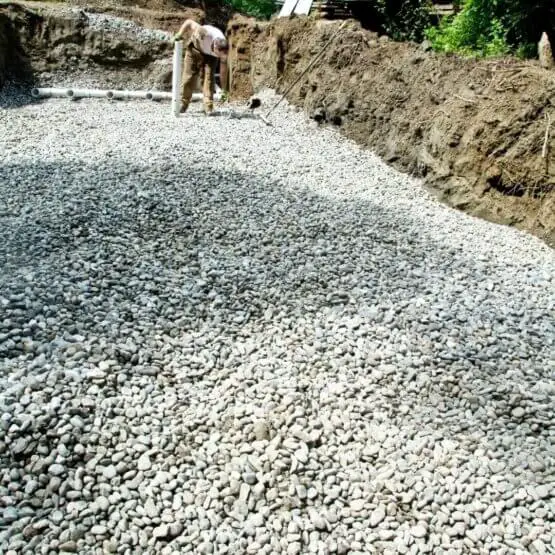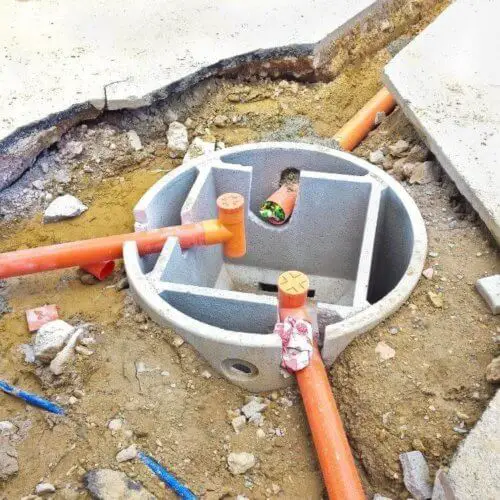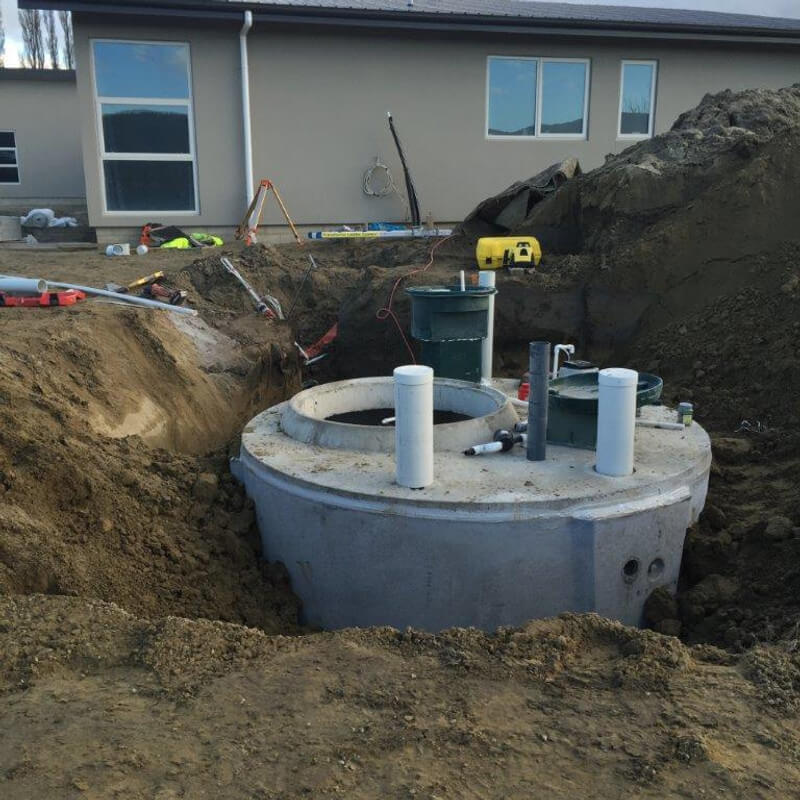The septic system refers to an on-site structure that treats and disperses household solid and liquid waste. One of the significant disadvantages of a septic system is that they take up a lot of space, especially for the leach field. This has led many to wonder can you have a septic tank without a leach field?
They seek an answer to this question in the hope that they can save up on the cost of constructing a leach field.
How the Septic System works

Before considering whether you need a leach field or not, you should first understand how the septic system operates. The septic system consists of all the components involved in residential or commercial wastewater treatment in areas without access to the municipal sewer systems. It is an underground system that treats and returns wastewater to the water cycle.
The septic system works with a blend of chemical and natural processes to clean and treat wastewater from your house. Typical septic systems contain a septic tank, leach field as well as piping that directs the wastewater into and out of the system [1].
Drain pipes from your toilet, sink, and bathroom or laundry room collect and lead solid and liquid waste into the septic tank. Here, the waste divides into three layers that are handled differently.
The bottom layer is made of heavier solid waste. It is digested into sludge by the chemicals and bacteria within the septic tank. With time, the sludge accumulates in the septic tank and needs to be removed by pumping.
The second layer consists of liquid waste, otherwise known as effluent. The effluent flows into the leach field through the outlet of the septic tank. The leach field, on the other hand, is made of perforated pipe or drain networks that distribute wastewater evenly within it.
This water is then allowed to percolate through gravel and sand into the soil. Microbes and bacteria in the soil treat the water further before it joins the groundwater system.
The top layer is made up of oil and grease and is called scum. It floats because it is less dense than water. The accumulation of scum sometimes requires the use of additives to break it down. Common additives used in this case are organic solvents.
Because the septic tank does not wholly treat wastewater, a leach field is necessary to complete the process. Complete treatment is required to ensure that the wastewater is safe before rejoining the water cycle [2]. This implies that the leach field is a critical component of the septic system.
Can you have a septic tank without a leach field?

Under normal circumstances, you cannot have a septic tank without a leach field. Lacking a leach field would imply that you have to pump your septic tank almost on a monthly basis. And you may discover that the cost of pumping significantly adds to your utility budget.
Therefore, if you do not have the budget for regular pumping and maintenance of the septic tank, you should have a leach field installed with your tank. There are unique situations in which you can install a septic tank without the accompanying leach field. These will be considered next.
Circumstances where you can have a septic tank without a leach field

- Old types of septic systems
Some homeowners buy a property that is several decades old. Farmhouses and other residential property built over a hundred years ago may not use the conventional septic system for water treatment. If you own such a structure, you may not even be able to locate the septic tank itself because there may be no records to indicate its position.
Houses built over a century ago have old types of septic systems. This is a system that consists of a septic tank without a leach field. The wastewater from the system would therefore flow directly from the septic tank into a nearby stream or drain way.
While this might not be the most eco-friendly approach to handling wastewater, it used to work for them.
If you have such a house with an old type of septic system, chances are that you will encounter trouble with the authorities. Septic systems that empty wastewater into water bodies are not legal in the current world with the heightened environmental consciousness. [3]
You may therefore be required to install a new system adhering to these regulations if the matter comes to light.
- Lack of space for the leach field
Lacking space to install a leach field with the septic tank happens on infrequent occasions. This is because building regulations in most localities specify the minimum lot size for those who wish to have on-site septic systems. Failure to adhere to these regulations might have serious legal ramifications.
But sometimes, you may inherit or buy a property where installing a leach field is not feasible. This may call for creativity in finding what may work for your septic system without the accompanying leach field.
For instance, you may want to consider pumping the tank on a regular basis. The other option is to install a septic system that operates without the leach field. This kind of system will be discussed later in this article.
- Your proposed leach field fails the percolation test
As discussed above, the leach field disperses the wastewater by allowing it to percolate into the soil. It is within the soil that further treatment by microbes is carried out. This is necessary to ensure that the water flowing into the groundwater system is clean and safe enough.
Before a leach field is constructed, a percolation test (or perc test) is carried out. The test is intended to evaluate the capacity of the soil in the leach field to absorb and retain water. [4]
If the field fails the percolation test, it means that it cannot properly absorb and retain moisture. If a leach field is constructed on such soil, it will result in flooding of septic water.
Failure of the percolation test means that you will have to consider an alternative septic system. This might involve installing a septic tank without the leach field or finding other ways to complete the treatment of wastewater.
- When installing certain types of septic systems
Certain types of septic systems can function without a leach field. These include the sand filter and evapotranspiration systems. Their functioning will be discussed in detail later.
- Field with shallow water table or bedrock
Septic systems built on land with a shallow water table might need to function without a leach field. The same is true for an area with shallow bedrock.
As wastewater percolates into the soil from the leach pipes, the microbes in the ground need sufficient distance and time to treat it completely.
Where the water table is near the surface, complete treatment may not have occurred by the time wastewater reaches the water table. This means that the groundwater reservoir will be contaminated and rendered unsafe for human, animal, and plant life.
It is somehow different for fields with shallow bedrock. Because the bedrock is impervious to water, the wastewater reaching it will be forced to accumulate. The end result will be a flooding of the leach field, rendering it unsuitable for use.
Therefore, if your land has either or both of these properties, you should consider having a septic tank without a leach field.
- When there is a nearby water body sensitive to water pollution
Similar to the shallow water table scenario, land close to water bodies prone to pollution should not have leach fields installed on them. The wastewater from the field will join the water body before being fully treated. This will have a severe effect on such water bodies.
Water habitats for endangered animal and plant species are susceptible to any level of pollution. Even the slightest buildup of toxins can render the species extinct.
It is therefore recommended that you consider alternatives to conventional septic systems if you dwell near such water bodies. And one of the approaches might be having a septic tank without a leach field.
Common Septic Systems Without a Leach Field

- Circulating sand filter system
The system consists of a closed chamber in which sand is used to filter the effluent. The system can be built below or above ground. From the septic tank, wastewater flows into the pump chamber that pushes it into the sand filter. The filter consists of a concrete or PVC chamber full of sand material.
The effluent from the pumping chamber enters the filter at the top. It then flows from the pipes by gravity through the sand, where it is treated and filtered. Depending on the setting, the water from the sand filter can be recirculated through the system to ensure complete treatment before being released to the nearby water body [5].
Although the sand filter system is costly to install and maintain compared to conventional septic systems, it is much more efficient. It also integrates oxygen into the water to aid in further breakdown of organic content.
The resulting purification means that the water can pass directly into the soil without having to go through a leach field. It is beneficial for areas with sensitive ecosystems, nearby water bodies, or high groundwater tables.
- Evapotranspiration system
Although this system has a drain field, it is not like the ordinary leach field. The septic tank drain field layout is in such a way that the base is lined with waterproof material. This means that the effluent is not allowed to percolate into the soil.
When the effluent from the septic tank enters the field, it is made to evaporate into the atmosphere and never joins the groundwater.
This system is unique and requires a special environment to operate in. For one, there should be enough heat, and the atmosphere should be dry enough to evaporate the effluent. This means that they work well in arid and semi-arid lands where there is plenty of sunshine and temperatures are sufficiently high to facilitate evapotranspiration.
The evapotranspiration system is recommended for soils with shallow water tables or a bedrock near the surface [6]. The only challenge with this system is if it rains, snows, or there is the absence of sunshine. The field becomes flooded and may lead to wastewater backing up the drain.
Can you build a house without septic system?

Yes, you can build a house without a septic system. But the house will need to be connected to a centralized waste management system. Otherwise, the waste will accumulate in the place and become a health hazard for you and your family.
The days are gone when households did not need indoor plumbing. Those were the days when there was enough space to build outdoor plumbing systems without affecting the environment. These days, however, you only have two options when it comes to handling household waste.
You either have to build your own septic system or have to rely on the municipal sewer system. For those who lack the space and resources for a system on-site, connecting the municipal sewer line is the next best alternative.
Read Also: Common Septic Tank Problems
So, can you have a septic tank without a leach field?
There are a few situations in which having a septic tank without a leach field might be tenable. These include cases where there is no space, the house is near an environmentally sensitive water body, or if your field fails the percolation test.
For these scenarios, you need an alternative to the conventional septic system. Options such as installing a recirculating sand filter or evapotranspiration system might work for you. While these systems might be expensive, they are just as effective (if not better) in handling waste as conventional systems.
So, yes, you can have a septic system without a leach field.
It is essential that you assess your situation first before choosing the type of septic system to install. You might even need to engage an expert to help you decide the solution that works best for you. It might be that your property can work with a septic tank without a leach field.

Michael Davis is a heating & plumbing expert who currently works as independent contractor in SC. He also writes for Plumbertip.
For almost 10 years he worked on various plumbing tasks across South Carolina.


